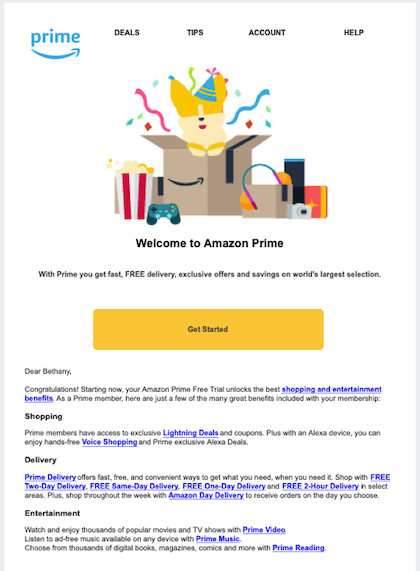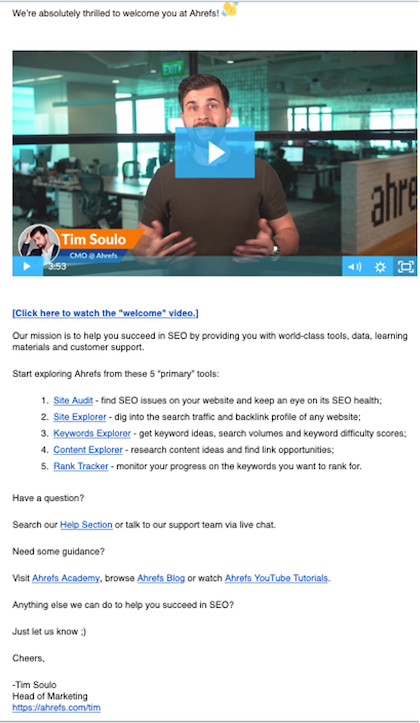Sending a warm welcome message to customers goes a long way in establishing rapport and familiarizing your audience with your utility’s offerings. An effective welcome email tees up your audience for more inbox communications and lays the foundation for a positive customer experience.
When following welcome email best practices, your messages should do five things:
- Thank customers for joining
- Help customers get the most out of your offerings
- Invite engagement through calls to action
- Provide immediate value
- Set the tone for future email communications
At the start of their relationship with your energy utility, customers are more receptive to messages about your programs and services (think paperless billing and outage alerts). And once they graduate from a Welcome Series, they will be more engaged with subsequent communications — by a lot. Questline Digital’s Benchmarks data shows recipients of welcome emails are 30% to 50% more likely to open future emails compared to customers who don’t receive welcome emails from their energy utility.
Don’t miss your opportunity to communicate essential onboarding information and build strong digital customer relationships.
Quick Tips: 7 Welcome Email Best Practices
Follow these seven tips to accomplish customer engagement and onboarding goals with your energy utility’s welcome emails.
- Use a straightforward subject line.
- Keep messages succinct and focused on improving customer lives.
- Use pre-scheduled, automated emails to maximize engagement.
- Send the first email immediately upon service signup and trickle in additional details over the next 30 days.
- Include three to five emails in your Welcome Series.
- Employ segmentation.
- Regularly test and evaluate email content.
Use a straightforward subject line. Welcome emails are not the place to try click-bait subject lines. Instead, be transparent and straightforward. Try something simple like, “Thanks for letting us into your inbox! Now what?” or “Welcome to [utility name] — Let’s get started.”
Keep messages succinct and focused on improving customers’ lives. Make your messages short and use subheads, icons and bullets to make reading easy. Customers are busy and don’t have time for complex emails. Similarly, only include information that is imperative to customer success. Welcome emails should serve as scannable resource centers.
Use pre-scheduled, automated emails to maximize engagement. Makes things simple for yourself and build automated workflows for your welcome messages. You can build a single workflow that spreads out messages, sending them a few days apart. Or you could build multiple workflows, sending secondary emails based on actions taken (or not taken) in the first send.
Send the first email immediately upon service signup and trickle in additional details over the next 30 days. Send email number one immediately upon signup and schedule the rest to follow a planned cadence. Consumers assume either they did something wrong or your systems don’t work if they don’t get a welcome email right away.
Welcome Series with three to five emails perform best. With years of experience managing Welcome Series for utilities, Questline Digital data shows that sending too many or too few messages can equate to lost opportunities. The best-performing welcome email series templates include three to five emails.
Employ segmentation. Welcome email best practices include using segmentation to build multiple campaigns for different audiences. New customers, moving customers, small businesses and large businesses all need unique resources from their utility. Don’t disappoint customers with welcome resources that don’t address their specific requirements.
Regularly test and evaluate email contents. While automation allows you to technically “set it and forget it,” you should evaluate your welcome emails on a seasonal basis, or at least annually. Look to see if some topics receive more engagement than others, if CTAs are performing, and if the number of messages and cadence is successful.
Check out this mini case study from a fellow utility who whittled down their Welcome Series after evaluating the data. They dropped from six emails to five and reprioritized messages, ultimately improving engagement results.
Welcome Email Series Template for Energy Utilities
Every energy utility is different, but the content that often performs best in a Welcome Series campaign includes:
- Introductory thank-you message. This is the most important message that receives the highest level of engagement. Keep it succinct and focused on improving customers’ lives.
- Billing and digital channels. This message has the second-highest engagement rate. Introduce customers to your utility’s billing options and digital channels.
- Outage resources. Inform customers of the variety of ways to receive outage updates and invite them to register for text notifications.
- Community involvement. Use this message to focus on your energy utility’s community efforts and partnerships.
- Safety or energy savings. Engage and educate customers on safety topics through videos, infographics or interactive quizzes. This message can also take a savings focus with promotions about energy efficiency rebates and programs.
Your utility may have different goals or messages to promote, but this flow of information — from thank you to must know to value-add — will help set up your customers for success.
Examples of Welcome Email Best Practices in Action
The best welcome email series follow a template. They always say “thank you” and help customers get the most out of company offerings. The following examples showcase welcome email best practices in action.
Nordstrom: This welcome message clearly illustrates the benefits of being a Nordy Club member and prompts customers to download a mobile app. Recipients feel taken care of and know what to expect going forward.

Amazon Prime: This welcome email has a clear CTA of “get started” along with secondary links to specific benefits. Amazon makes it clear they want me to finish building the customer’s profile in order to deliver the best customer experience.

Ahrefs: Using video to share a warm welcome message to customers helps to elevate your brand.This email also includes links to Ahrefs’ five main tools so customers can gain value right away.Subsequent emails include recaps and links to their most popular and helpful blog content.


